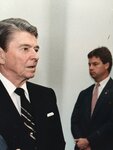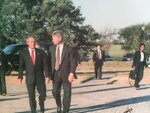

Editor’s Note: This story was originally published in the Hood County News. It is being shared here due to the broad nature of the story and the fact that many in our community are interested in the events of July 13.
The nation is still reeling from former President Donald Trump’s attempted assassination during a campaign rally in Butler, Pennsylvania Saturday, July 13.
THE SHOOTING
Although the incident is still being investigated, it was revealed that the shooter, 20-year-old Thomas Matthew Crooks, opened fire at the former president using an AR-style rifle. Trump — who was immediately surrounded and protected by Secret Service as he was rushed into a vehicle for safety — suffered an injury to his ear.
According to CNN, Crooks, who was killed by Secret Service agents following the shooting, fired on Trump while perched on a nearby rooftop outside the rally’s security perimeter.
The shooting resulted in the death of one rally attendee and left two others critically injured; however, the two injured have since been reported as stable.
As investigation of the incident continues, the Secret Service faces significant scrutiny and demands for congressional investigations regarding its management of security at the rally, according to CNN.
There have also been rumors circulating that some Secret Service agents were involved in the assassination attempt, while others have suggested that the entire incident was staged, either by Trump or President Joe Biden.
TikTok, X, Facebook, and other social media platforms have also been flooded with dark humor in the aftermath of the shooting, with numerous memes surfacing to make fun of the situation and Trump himself.
A CALL FOR PATIENCE
While many details surrounding the incident remain unclear at this time, former Secret Service agent and Hood County resident Mark Lowery urges the community to remain patient and understanding as the investigation unfolds.
“Don’t judge the Secret Service until a competent, transparent, and timely investigation has been completed,” he wrote, in a Letter to the Editor. “This is a complex and challenging responsibility. Until one has performed this duty, one cannot understand the depth of responsibility and level of detailed work it requires to be successful in each and every event. I have performed countless site advances, many much larger than this one in Butler, Pennsylvania. I have questions like many of you, but I also have a perspective many of you do not have. I ask that all of us refrain from critical judgment, spreading uncorroborated information and humorous memes.”
Lowery — who served in the Secret Service for 24 years and retired as the Senior Executive Service Special Agent in Charge — shared that the Secret Service has a motto: “We don’t make history. But we sit on the front row of history and observe it.”
“It’s a very demanding job and a very challenging job,” Lowery told the Hood County News. “It’s 24/7. You can’t fail. We saw what happened on the 13th of July. It could have been much more tragic. I asked people to think, ‘Would that have potentially changed the history of our nation in the world?’ I think it would have.”
The responsibility of the Secret Service, Lowery said, is to “keep our protectees alive,” so they can freely make decisions to lead the country — and the world — without fear of assassination.
HISTORY
One of America’s oldest federal law enforcement agencies, the Secret Service was originally created in 1865 during the Civil War to stamp out rampant counterfeiting in order to stabilize America’s young financial system, according to secretservice.gov.
It wasn’t until the assassination of President William McKinley in 1901 that the Secret Service was tasked with the full-time protection of the president of the United States.
Throughout the years, protective details of the Secret Service have grown and evolved, often in response to assassinations, close calls or other major security events, according to ABC News. In fact, Lowery said the Secret Service has had a “successful career” in preventing assassinations since presidential candidate Sen. Robert F. Kennedy's assassination in 1968.
“Our protection responsibilities and investigations have expanded throughout the years,” Lowery said. “There was an attempted assassination on (politician) George Wallace in the early 70s, President (Gerald) Ford had two attempts on his life, President (Ronald) Reagan had an attempt on his life, and of course, the attempt on President Trump’s life. We’ve had a very successful career, if I may, in preventing assassinations.”
BEHIND THE SCENES
Lowery explained that new recruits in the Secret Service undergo a period of assessment in the field office to determine their suitability for high-stakes assignments, including the president's detail. He emphasized that agents are closely monitored during this time to ensure they are trustworthy.
"There's a period of time when the agency is watching the agents to see who's really suitable to go to the president's detail. You got to fully know this person,” he explained. “The Secret Service can't put somebody next to the president of the United States and have any concerns they're going to harm them, man or woman.”
While there can be anywhere from 20 to 200 Secret Service agents assigned to protect the president at any given time, Lowery explained that the number varies based on the specific site and event. He also clarified that agents typically surround the president as part of their "working shift,” noting that the number of agents in that shift is usually pretty set but can vary based on circumstances.
“It's a tremendously responsible job, and the history of the world hinges on the safety of our world leaders and for them to be able to work in a safe environment without worry of assassination,” Lowery said. “If we can't provide that to them, it's going to impact their ability to serve the American people.”
Reflecting on his own experience, Lowery noted that his understanding of protection deepened significantly after joining the White House detail. He said he thought he had a solid grasp of security protocols, but since learned there is a vast array of sophisticated tools and strategies in place to ensure safety at high-profile events.
“It's not until you actually go to the White House detail do you see the depth and the tools that are available, the sophistication of what protection’s really like, and the complexities it takes to make a venue safe," he said.
He recounted a significant event during President Reagan’s visit to an auditorium at Ohio State University, where approximately 12,000 people had gathered. As guests passed through the security screening, Lowery said he and his team were prepared for the president's arrival in about 20 minutes when they received an alarming call about a potential bomb threat in the building.
“I could make the decision to direct the motorcade and president to not come to the site, but ultimately my decision was to bring the president and the event went without incident,” he explained. “But I also looked out and saw 12,000 souls, men, women and children that didn't come to that site that day and expect to be hurt, so that's the responsibility that I don't think people understand.
“Unfortunately, that agent (in Butler) will live the rest of their life knowing that someone lost their life at their site, and that's a huge responsibility. And that responsibility never goes away.”
UNDER REVIEW
Lowery expressed his belief that the attempted assassination on Trump should never have occurred. He shared his confidence that a thorough advance was performed on the outdoor venue, despite challenges posed by factors like long-range visibility and high ground.
“Once the investigation has concluded, we will know from a survey report on what their plan was,” he said. “There's assignment logs for each and every police officer and each and every agent. We will know who was supposed to do what, at that venue ... Clearly, something broke down in the execution of that, but we the people right now don't know what happened.”
Lowery said the protective shift did a “marvelous job” during the incident, stating that they acted effectively to protect the former president. He noted that as soon as Trump realized he had been shot, he instinctively dropped down, prompting the agents to quickly surround him and form a human shield. Lowery acknowledged that some people questioned why the presidential candidate wasn’t evacuated sooner but emphasized there was an active gunman at the scene. He said once the shooter was neutralized, the agents assessed the former president's condition, checking for any additional injuries and ensuring he was alert and able to communicate.
“They executed their plan precisely the way it was designed to play out,” he said. “You don't want to move a protectee into another gunfight."
Lowery added there is a high likelihood that if the counter sniper team had not neutralized the shooter, he would’ve continued to shoot into the crowd, possibly injuring not only the Secret Service agents and Trump, but more citizens as well.
“It was a tremendous shot (by the counter sniper) — even though it was not a long-range shot — but it probably prevented the loss of life,” he said.
Lowery also voiced concern about the spread of conspiracy theories and unverified information on social media before the investigation into the attempted assassination has completed — labeling it dangerous and unhealthy for the community and the nation as a whole.
“I just ask people to please don't criticize Secret Service agents who were working without having the facts,” he said. “I was frustrated after watching the four-and-a-half hours of testimony (of the director) but I have complete confidence at some point we will know what was planned. Until that time, I’m deeply disturbed by the American people, friends of mine, and residents within this community who are spewing social media conspiracy theories and throwing out supposedly evidence that they found without knowing the facts — and that's dangerous. It's not healthy for them. It's not healthy for America.”
Lowery emphasized that while the Secret Service can conduct extensive training at its Beltsville facility, including drills for “assaults on principles” with flashbangs and dummy rounds, nothing can fully prepare agents for real-life scenarios.
“I've been involved in shootings,” he said. “And until you're there, the scream of the crowd, the sounds, the madness that's going on, you can't train that to the level of real life.”
It may take a while before all of the facts behind Trump’s assassination attempt are revealed — but until that time, Lowery urges community leaders and elected officials to take a stand and guide residents in refraining from posting their speculations on social media.
“I am confident the truth will be provided,” his Letter to the Editor states. “I am expecting a competent and transparent investigation! From my experience, there are preliminary surveys, post assignment logs, CP Logs, and many witness interviews that will determine what went very wrong at this rally. This should have NEVER happened!”